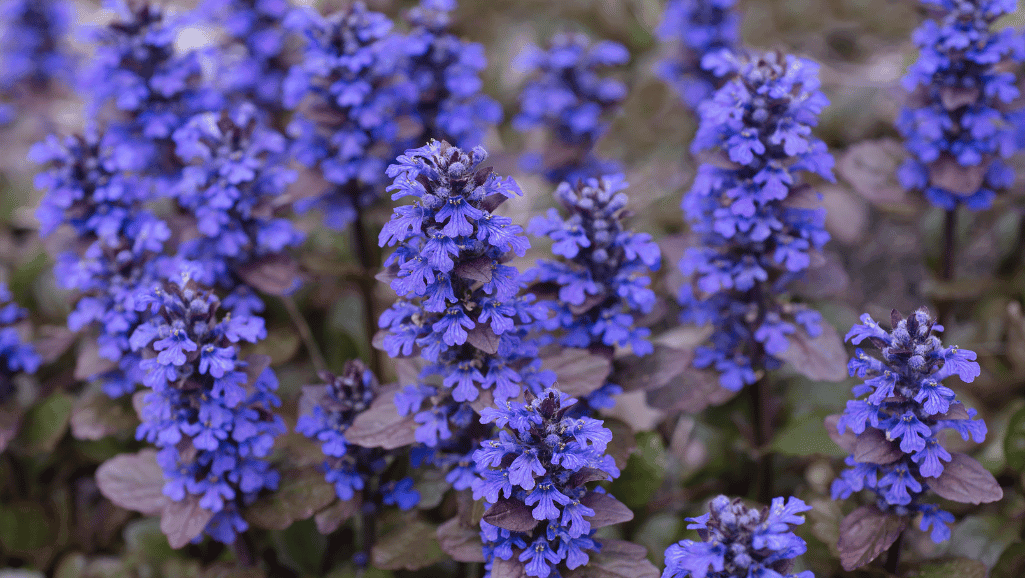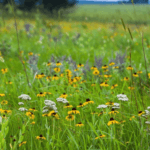
Beautiful flowers gardenia Plants For Your homes

Ajuga reptans, also known as Bugleweed or carpet bugle, is a top pick for gardeners wanting vibrant, healthy groundcover plants. It thrives in full sun to partial shade and comes in many colors. Knowing how to care for Ajuga is key to having a beautiful Ajuga ground cover that also keeps weeds away. It’s important to manage its fast growth, especially in areas where it can become invasive.
Ajuga can spread up to 90cm and shows off beautiful flowers in shades of blue and violet. But, it needs watch for powdery mildew and should be divided every two to three years to stay healthy. With many varieties like ‘Alba,’ ‘Burgundy Glow,’ and ‘Black Scallop,’ picking the right Ajuga can be fun and strategic. You can find Ajuga at garden centers or online at places like Crocus and Chiltern Seeds, making it a great choice for your garden all year round.
To foster a healthy Ajuga reptans care guide, embrace both its robust nature and its need for environmental control.
When thinking about Ajuga reptans for ground cover, it’s key to explore its botanical name and features. This section will introduce you to Ajuga reptans, covering its botanical details, natural habitat, and its role as a ground cover.
Ajuga reptans, also known as bugleweed or creeping bugle, is a standout in landscaping. It’s a hardy perennial that forms a dense, mat-like cover. It grows about 4 inches tall, with flower spikes reaching up to 9 inches. The leaves come in rich colors like green and burgundy, adding beauty to gardens.
In May and June, it blooms with flowers in blue, pink, purple, and white. These flowers add a pop of color to the lush foliage.
Ajuga is found in temperate regions of Eurasia, Africa, and Australia. It’s adaptable to different climates and conditions. It thrives in USDA Hardiness Zones 3 to 10, making it versatile for various landscapes.
Some varieties like ‘Black Scallop’ and ‘Chocolate Chip’ are best for zones 3-9. This adaptability makes Ajuga a great choice for gardens of all sizes.
Ajuga is known for its beauty and low maintenance in landscaping. It forms dense clusters that keep weeds away and provide a consistent color. This makes it a top pick for gardeners and landscapers.
It can handle foot traffic and resists pests like deer. These features highlight why Ajuga is a top choice for ground cover landscaping.
To grow Ajuga, or bugleweed, well, you need to know the best conditions for it. It’s important to get the right amount of sunlight, soil, and water. This way, you can enjoy its beautiful colors and full ground cover.
Ajuga likes a mix of sunlight and shade. It can handle full sun but prefers partial shade, especially in hot places. Experts say 3-4 hours of sunlight a day is best for its health and growth.
For Ajuga soil preferences, go for well-drained soil rich in organic matter. The soil should be slightly acidic to neutral, with a pH of 4.5 to 6.5. Adding compost or manure can help with nutrients. Ajugas don’t need much fertilizer but may need some if the soil is poor.
Getting the watering right is key for Ajuga. Start with about 1-2 inches of water a week, including rain, in hot or dry areas. Once it’s grown, keep the soil moist but not too wet to avoid crown rot.
By following these growing conditions for Ajuga, you can make sure your plants do well. Whether you have ‘Black Scallop’ or ‘Burgundy Glow’, the right care will make your garden beautiful.
| Variety | Color | Height | Spread | Zones |
|---|---|---|---|---|
| Catlin’s Giant | Green | 3-6 inches | 12-24 inches | 3-9 |
| Blueberry Muffin | Blue-green | 6 inches | up to 28 inches | 4-9 |
| Burgundy Glow | Burgundy and green | 6-10 inches | 6-24 inches | 5-9 |
| Purple Brocade | Deep green | 3-10 inches | 6-18 inches | 3-9 |
| Toffee Chip | Variegated | 2-6 inches | 12-18 inches | 3-10 |
Exploring Ajuga varieties shows a wide range that can change any landscape. Ajuga, or bugleweed, is known for its strong growth and bright leaves. It’s great for covering the ground and solving gardening problems. Let’s look at some popular Ajuga types, their colors, and how to pick the right ones for your garden.
The ‘Black Scallop’ and ‘Chocolate Chip’ Ajuga types are very popular. They have dark and rich leaves that stand out. ‘Burgundy Glow’ has leaves that turn bronze in fall, showing off the wide range of colors Ajuga plants offer.
Ajuga plants make a big statement with their colors. ‘Atropurpurea’ has deep bronze-purple leaves, while ‘Dixie Chip’ has striking colors. They offer a variety of colors that other groundcovers can’t match.
Their flowers come in blue, pink, and white in spring and summer. This adds a lively contrast to the leaves. For tips on growing Ajuga, check out this guide at selecting Ajuga plants.
When picking Ajuga for your garden, think about each type’s traits and your local climate. ‘Catlin’s Giant’ is great for tall flowers, while ‘Silver Beauty’ has subtle colors with silvery-green leaves. Choose based on how well the plant fits your garden’s look and needs.
Ajuga plants are also practical. They stay green, control weeds, and are easy to care for. They’re perfect for gardens in different climates. For more tips on using Ajuga in tropical gardens, see this guide at selecting Ajuga plants for tropical climates.
Exploring Ajuga varieties shows they’re more than just ground cover. They add colors, textures, and change with the seasons. This makes them key to creating lively gardens all year.
When planting Ajuga reptans, careful planning and spacing are key for a lush ground cover. We’ll look at the best ways to plant and space Ajuga for a healthy growth.
For a thriving Ajuga ground cover, follow these steps: Pick a spot that lets the plant spread out and has good air flow to prevent diseases. Use soil that drains well and keep the area weed-free. Make sure to dig holes that fit the plant’s mature size to avoid crowding.
Ajuga spacing considerations are key for a healthy and good-looking ground cover. Giving Ajugas enough space helps them grow strong roots and spread out well. This creates a thick mat that keeps weeds down and holds moisture in.
| Variety | Height | Spread | Recommended Spacing |
|---|---|---|---|
| Catlin’s Giant | 3-6 inches | 1-2 feet | 10-15 inches |
| Blueberry Muffin | 6 inches | up to 28 inches | 8-12 inches |
| Burgundy Glow | 6-10 inches | 1-1.5 feet | 6-12 inches |
| Purple Brocade | 6-9 inches | 1-1.5 feet | 10-15 inches |
Following Ajuga landscaping tips and spacing them right makes the plants healthier and your landscape look better. Keep an eye on the spacing and adjust as needed to keep your Ajuga ground cover looking great.
Learning how to Ajuga propagate is key for gardeners wanting to grow or expand their gardens with this tough ground cover. It’s a way to refresh your garden and multiply Ajuga ground cover easily. Experts on planting and gardening offer great advice on these methods.
Division is a top choice for Ajuga propagation because it’s fast and effective. You uproot a big plant, then split it into smaller pieces. Each piece should have strong roots for a good start. Do this in spring or fall to skip the harsh weather.
Using Ajuga reptans is smart because it grows well in many places (USDA Zones 3-11). This makes sure your new plants will thrive.
If you want to start Ajuga from seeds, it’s a great option. Plant seeds indoors in early spring in a good soil mix. They grow quickly and can move outside when they’re strong enough.
It’s important to mimic nature’s conditions. Ajuga likes temperatures between 55-70°F during the day. This is key for seedlings growing from seeds.
| Method | Time to Establish | Ideal Conditions |
|---|---|---|
| Division | Immediate transplant possible | Moist, pH 6.0-6.5, avoid extreme temperatures |
| Seeds | Several weeks to sprout | Indoor germination at 55-70°F |
| Root Cuttings | 3 months for emergence | Grows in full to partial shade, moist conditions |
Dividing and sowing seeds are great ways to grow your Ajuga garden. They make your garden look beautiful and help keep the soil in place. Using these methods, gardeners can make sure Ajuga grows well in different gardens.
Maintaining Ajuga in your garden keeps the plant healthy and your landscape beautiful. Ajuga is great as a groundcover because of its vibrant leaves and lovely flowers. But, it needs some care to grow well with other plants.
Good seasonal Ajuga care keeps your groundcover looking great all year. In spring, make sure Ajuga gets enough water after the dry winter. In summer, give it some shade to protect the leaves from getting too hot.
In fall, trim back any thick spots to improve air flow. This helps prevent diseases. Pruning Ajuga’s runners keeps it from spreading too much and reduces competition with other plants like arborvitae and azaleas.
Controlling Ajuga growth can be tough because it spreads a lot. Prune the runners often to keep it in check and promote healthy growth. Also, divide your Ajuga every 3-4 years to control its spread and boost its health.
This helps prevent overcrowding, which can lead to disease from poor air flow.
When it comes to Ajuga fertilization, a little goes a long way. Ajuga doesn’t need a lot of food, and too much can cause weak, disease-prone growth. If your soil is very poor, a small amount of balanced, organic fertilizer in the spring can help.
Ajuga is tough and can handle a lot, but the secret to keeping it healthy is careful attention. Doing the right things at the right time and in moderation will keep your Ajuga looking great. This makes your garden more beautiful.
Pruning and grooming Ajuga plants are key to keeping them healthy and looking great. By doing this, you can stop pests and diseases before they start. This keeps your garden beautiful and full of life all year.
Pruning is crucial for keeping Ajuga plants strong. Cutting back the runners stops them from spreading too much. This lets them bloom well during the growing season.
Also, clip the flower spikes after they bloom. This keeps the plant looking fresh and encourages new growth. This way, your Ajuga stays thick and lively.
Ajuga plants are tough but can face problems like aphids and crown rot. To get rid of aphids, just spray them with water. This knocks them off without using harsh chemicals.
To stop Ajuga diseases like crown rot, make sure the soil drains well and air moves around the plants. Catching these problems early helps keep your Ajuga healthy.
| Groundcover Plant | Blooming Season | Special Requirements | Height and Spread at Maturity |
|---|---|---|---|
| Ajuga reptans ‘Atropurpurea’ | Summer | Well-drained soil, partial shade preferred | 10-50 cm height, 50 cm to 1 m spread |
| Blue Dawnflower (Ipomoea indica) | Late spring to early fall | Needs full sun | n/a |
| Coral Honeysuckle (Lonicera sempervirens) | Early spring to early summer | Temperature tolerance to -30°F | n/a |
| Trumpet Vine (Campsis radicans) | Midsummer to early autumn | Frequent pruning required | n/a |
By using these special pruning and care tips for Ajuga, your groundcover will do great. It will add color and life to your garden.
Adding Ajuga landscape design to your garden boosts beauty and supports a lively ecosystem. Ajuga is perfect for many design styles and planting spots because it’s so adaptable.
Ajuga works well with many companion plants. When placed thoughtfully, it changes gardens with its full, colorful leaves and flowers.
Designing with Ajuga means knowing how these plants work together for a beautiful landscape. Ajuga’s colors and textures make gardens look good, from classic to modern.
Ajuga’s colors, from deep purples to bright greens, add depth to gardens. Its leaves, smooth or crinkled, let you create detailed designs.
Using Ajuga in layers by height and color works well in big, open areas. It fits well on slopes and borders, doing better in shade and needing less upkeep than regular grass.
Planting with Ajuga makes gardens prettier and helps nature by drawing in bees, butterflies, and birds. This makes the garden a better place for all living things.
In conclusion, making the most of Ajuga means picking the right plants and valuing its natural beauty. With Ajuga, simple gardens turn into colorful, lively places that stay beautiful all year.
Ajuga, also known as bugleweed, shows off its beauty with a unique bloom cycle in mid to late spring. This cycle is key for gardeners who want to add color and texture to their gardens. Knowing how to manage this cycle helps you enjoy Ajuga flowers and keep the plant healthy all year.
To enjoy Ajuga flowers, make sure the plants get the right conditions. They love partial to full shade, making them perfect for shady spots. During bloom, Ajuga attracts bees and butterflies with its nectar-rich flowers. These flowers come in colors like blue, purple, and pink, adding beauty to shaded areas.
For the best view and health of Ajuga during bloom, just let nature shine. Don’t mess with the plants too much, so their beauty can be the main focus of your garden.
After Ajuga blooms, taking good care of it is crucial for its health and looks. Pruning or mowing helps keep the garden neat and stops the plants from getting too thick. This also helps prevent diseases by letting air move around the plants.
After the bloom, check the soil and make sure the area isn’t too crowded. This prevents mold or mildew, which can harm the plant when it’s not actively growing.
| Month | Percentage of Blooming Ajuga | Notes |
|---|---|---|
| March-April | 10% | Early starters depending on region |
| May-June | 75% | Peak bloom period |
| July-August | 15% | Extended blooming in optimal conditions |
| September-October | 0% | Generally, no blooming |
By following these tips, you can make your Ajuga a lasting part of your garden. The flowers and foliage after bloom create a beautiful, eco-friendly carpet. This adds color and texture that’s great for the garden.
Keeping Ajuga plants healthy means watching out for problems like yellow leaves and crown rot. These issues often come from environmental stress. Here are some key tips and strategies to keep your groundcover looking great.
Yellow leaves on Ajuga can mean too much water or poor drainage, which can cause crown rot. This is bad for the plant. Here’s how to fix Ajuga health problems linked to too much moisture:
Poor sunlight can make yellow leaves worse, as Ajuga needs the right amount of light to stay colorful. To fix poor lighting and too much moisture, try these steps:
Keep an eye on your Ajuga plants and adjust your care as needed. This will help reduce yellow leaves and crown rot.
| Problem | Solution | Benefit |
|---|---|---|
| Excessive moisture | Adjust watering, improve soil drainage | Prevents crown rot and yellowing leaves |
| Poor sunlight | Relocate to partial sun areas | Enhances foliage color and health |
| Root-knot nematodes | Treat with organic nematicides | Protects roots, promotes robust growth |
By using these specific Ajuga care tips, gardeners can solve common problems like yellow leaves and crown rot. This keeps the groundcover looking good and working well.
We’ve looked at Ajuga care and its role in sustainable gardening. This plant, with over 40 species, is great for covering ground and adding beauty. It comes in many colors like blue, purple, pink, and white, and has unique leaves like ‘Bronze Beauty’ and ‘Black Scallop’. Ajuga is perfect for gardens because it controls erosion and is easy to care for once it grows.
Ajuga is also known for its health benefits. It has anti-inflammatory and antioxidant properties, similar to those found in sage and thyme. This makes it valuable for more than just its looks. Adding Ajuga to your garden means enjoying its beauty and using it in herbal remedies.
Ajuga is a top choice for gardens, offering both beauty and practical benefits. It grows well in different light conditions and gets along with other plants like Hosta and Astilbe. With the right care, Ajuga makes gardens colorful and supports local ecosystems.




